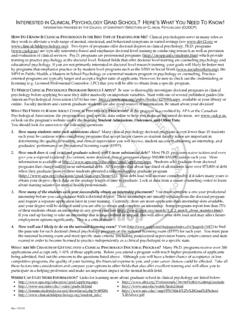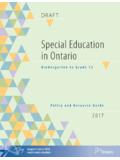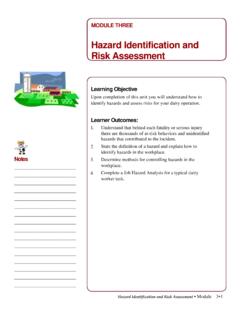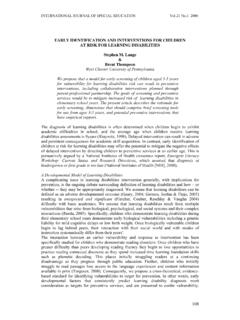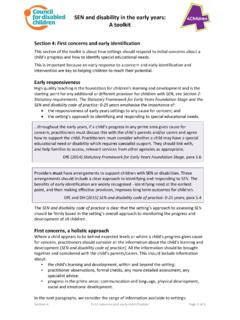Transcription of Five levels of self-awareness as they unfold early in life
1 Five levels of self - awareness as they unfold early in lifePhilippe RochatDepartment of Psychology, Emory University, 532 North Kilgo Circle, Atlanta, Ga 30322, USAR eceived 27 February 2003 AbstractWhen do children become aware of themselves as differentiated and unique entity in the world? Whenand how do they become self -aware? Based on some recent empirical evidence, 5 levels of self - awareness arepresented and discussed as they chronologically unfold from the moment of birth to approximately 4 5years of age. A natural history of children s developing self - awareness is proposed as well as a model ofadult self - awareness that is informed by the dynamic of early development. Adult self - awareness is viewedas the dynamic flux between basic levels of consciousness that develop chronologically early in life. 2003 Elsevier Inc. All rights IntroductionSelf- awareness is arguably the most fundamental issue in psychology, from both a develop-mental and an evolutionary perspective.
2 In this paper, I discuss this issue from the point of view ofdevelopment. I ask the questions: when do children become aware of themselves as differentiatedand unique entity in the world? When and how do they become self -aware? Based on some recentempirical evidence, I identify 5 levels of self - awareness as they chronologically unfold from themoment of birth to approximately 4 5 years of developmental approach in psychology is irreplaceable. It allows one to observe how basiccompetencies emerge and come on-line. By analogy, it compares to observing the construction ofa skyscraper via daily photographs taken during the process (I am thinking of a postcard I haveseen of the Eiffel tower in the various phases of its construction). It reveals what the final productis made of and the sequencing of each of its elements. It is some kind of a forward developmental psychology, one can observe forward engineering over and over are numerous, repeating patterns of growth that prefigure what we adults take forE-mail Rochat).
3 1053-8100/$ - see front matter 2003 Elsevier Inc. All rights (03) and Cognition 12 (2003) 717 731granted, such as self - awareness . Indeed, what does it mean and what does it take to recognizeoneself in a mirror? The response lays in children and their development of such capacity. At leastthat is what I would like to suggest general idea driving the paper is that prior to the expression of explicit self - awareness suchas self -recognition and self -identification in a mirror or a photograph, infants from birth manifestan implicit sense of themselves. The questions of interest here are (1) what are the contrasted levelsof self - awareness unfolding in early development? (2) what does this development tell us about thenature of self -knowledge in general? self -consciousness in developmentThere is a general consensus on a few major landmarks in young children s psychological de-velopment such as the manifestation of the first social smile, the first independent steps, or the firstwords.
4 All parents also notice an important change at around 2 years of age when childrenmanifest self -consciousness, the so-called secondary emotions such as embarrassment or pridein very specific situations such as mirror exposure or competitive games (Kagan, 1984; Lewis,1992). Prior to the second year, an infant placed in front of a mirror will typically smile, coo, andexplore in apparent delight of the perfect contingency between acted and seen movementsbouncing back at them from the polished surface of the mirror (Amsterdam, 1972). By 2 years, thespecular image is associated with radically different behaviors. Toddlers become typically frozenand sometime behave as if they wanted to hide themselves by tucking their head in their shouldersor hiding their face behind their hands. They show embarrassment. This is a robust phenomenonand one is naturally tempted to ask what it means psychologically for children in their devel-opment. The literary quote reproduced below captures this important transition:There is a thing that happens with children : If no one is watching them, nothing is really happening to them.
5 It is notsome philosophical conundrum like the one about the tree falling in the forest and no one hearing it: that is a puzzler forcollege freshman. No. If you are very small, you actually understand that there is no point in jumping into the swimmingpool unlesstheysee you do it. The child crying, Watch me, watch me, is not begging for attention; he is pleading forexistence itself. MontgomerySaying Goodbye: A memoir for Two poet Arthur Rimbaud claimed that I is some one Else ( Je est quelqu un d autre ),suggesting that we conceive ourselves through the eyes of others. It appears indeed that by 2 3years young children do start to haveothers in mindwhen they behave. The expression of em-barrassment that children often begin to display in front of mirrors at around this age is theexpression of such self -consciousness. They behave not unlike criminals hiding their face to thecameras. Their behavior indicates a drive to vanish from the public eyes, as if they came to grip viathe experience of their own specular image of how they present themselves to the world.
6 Not onlydo they discover in the mirror that it is themselves, they also realize that it is themselves asperceived by others. The malaise might come from the realization of a fundamental discrepancybetween how the child represents herself from within, and how he or she is actually perceived byothers as reflected in the mirror. Note that this interpretation is consistent with what visual an-thropologist Edmund Carpenter reported in adults of an isolated Papua New Guinea tribe (theBiami). The Biami presumably did not have any mirror experience and the river in the Papuanplateau are typically too murky to provide clear reflections, unlike the rivers of ancient Greeceenjoyed by Narcissus. The anthropologist recorded their reactions when looking for the first at718P. Rochat / Consciousness and Cognition 12 (2003) 717 731themselves in a mirror, viewing themselves in video recordings or Polaroid photographs. Car-penter describes reactions of terror and anguish: They were paralyzed: after their first startledresponse covering their mouths and ducking their heads they stood transfixed, staring at theirimages, only their stomach muscles betraying great tension (Carpenter, 1975, pp.)
7 452 453).If children begin to have others in mind by the age of 2 or 3 years, the question is how thisself-consciousness comes about? I will suggest that there are at least 5 steps to this progression,each corresponding to different levels of self - awareness . I will first describe these 5 levels of self - awareness in contrast to a level 0 of no self - awareness . In this description, I will use as illustrationsthe various reactions to the mirror infants and young children manifest as a function of have been criticized for lacking ecological validity (Loveland, 1986) and mirror self -recognition for not being a thorough index of self - awareness (Povinelli, 1995, 2001). However,reactions to mirrors remain a well documented, hence reliable (reproducible) behavioral index ofdeveloping self - awareness . I provide some empirical evidence of how levels of self -awarenessunfold chronologically between birth and early Various levels of self - awareness : The case of mirror reflectionWhat do children see when they see themselves in a mirror?
8 Do they see that it is themselves ordo they perceive someone else facing them? When do mirrors and their reflection begin to beconsidered for what they are, namely a solid polished surface that reflects back? As illustrated bythe image of Fig. 1, we can place surreptitiously a yellow Post-It piece of paper on a child sforehead. We then play with him to confirm that the child is oblivious that his forehead is nowadvertising such a yellow mark. As illustrated by Fig. 1, if we now place the child in front of amirror what does he see and what is he inclined to do? There are 6 possibilities, ranging from self -obliviousness (absence of self - awareness , referred here as Level 0 ) to self -consciousness. Beyondlevel 0, levels 1 5 correspond each to a particular level of self - awareness . I describe these levelsbelow, starting with Level 0 (absence of self - awareness ), then proceeding in the order of thelevels of self - awareness following their relative complexity, from implicit ( levels 0 2) to explicit( levels 3 5) (Rochat, 1997, 2001).
9 Level 0: ConfusionThis is the degree zero of self - awareness , level 0 at which the individual is oblivious of anymirror reflection, thus oblivious of the mirror itself. The specular image is confounded with thereality of the environment it reflects. It is perceived as a mere extension of the world, not a re-flection of it. Birds flying into mirrors would express such level, as they sometime accidentallycrash into windows. They mistakenly perceive mirrors as extension of the environment, notas differentiated objects. Pet owners know that placing a mirror in a canary cage is substitutefor companionship and triggers in the bird melodious courtship songs. It is also the level expressedby dogs, cats, or monkeys facing mirrors and posturing endless aggressive displays to theirown specular image as if they were confronting a creature other than themselves (Zazzo, 1981).Note that this level also characterizes moments of absence when we, adult humans, perceive andsometime frighten ourselves for an instant when experiencing our own mirror reflection as anotherperson surreptitiously facing Rochat / Consciousness and Cognition 12 (2003) 717 Level 1: DifferentiationThis is the first sign that the individual is not oblivious of mirrors as reflection.
10 At this level, thereis a sense that what is perceived in the mirror is different from what is perceived in the surroundingenvironment. More specifically, when perceiving the own specular image, the individual picks upthe fact that there is something unique about the experience, namely that there is a perfect con-tingency between seen and felt movements. Beyond the confusion of the preceding level, this levelentails some basic perceptual differentiation. Differentiation between the experience of own bodilymovements as reflected in the mirror and the direct experience of other moving entities in the is a first level of self -world differentiation: a differentiated self is Level 2: SituationBeyond the differentiation of the uniqueness of self -produced movements seen on the surface ofthe mirror, the individual now is capable of systematically exploring the intermodal link betweenseen movements on the mirror surface and what is perceived of the own body proprioceptively.

